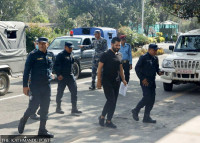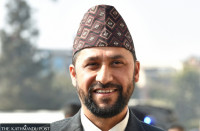National
UML ends west-east march, asserts problem-solving role
Leaders say campaign helped them understand people’s concerns. But experts say UML is unclear what it actually wanted from the march.
Post Report
The CPN-UML’s 18-day mid-hill march concluded in Chiwabhanjyang in Panchthar district on Sunday with a national flag hoisting ceremony. By raising the national flag near the India border in Sikkim, the party has tried to convey that nationalism remains a key element of its political agenda.
The KP Sharma Oli-led party had fared excellently in the 2017 general election—the first after the promulgation of the constitution—largely attributed to his strong stance against the Indian blockade. The recent campaign, called Jhulaghat-Chiwabhanjyang March for Prosperity, commenced on November 30 with an address by Oli in a mass gathering in Jhulaghat of Baitadi district.
The party’s supremo addressed 22 mass gatherings and dozens of corner meetings during the campaign. And he consistently emphasised a singular message—only a UML majority government can guarantee the country’s progress, so for those aspiring for prosperity, supporting the party is crucial. “Politics should guide the country in the right path and direction,” Oli said while addressing the concluding ceremony of the march on Sunday. “The UML is the only party that can dispel the current uncertainty.”
UML leaders said the campaign aimed to understand the real concerns of the people, economic and developmental. “The march helped us to understand the real problems facing the hill belt of the country,” Rajendra Gautam, publicity department chief of the party, told the Post.
The Oli-led march interacted with local communities in 26 districts connected by Mid-Hill Highway, also called Pushpa Lal Highway, named after the Nepal Communist Party’s founder. Dozens of party leaders and cadres covered 1,771 kilometres from the country’s far west to far east.
“We are excited by the reaction and the positive response showered by the people from the hills,” Gautam added. “While the party is reenergised by the response, it has also felt a responsibility to address the problems people have pointed out.” The party will make public its takeaway from the march after a proper evaluation and analysis next week, Gautam said.
Those who have closely followed the UML’s campaign view it as a positive development towards connecting with the people.
Sanjeev Humagain, coordinator of MPhil programme for social science at Nepal Open University, said it is good that parties have started realising that reaching out to the people only at the time of elections is not enough.
“I take the UML’s march as a positive departure towards building connections with the people even before elections,” he told the Post. “However, the UML doesn’t seem to have clarity on what it actually wants to achieve from the march.”
Despite claiming that the march was not solely political, Oli in most of his speeches attacked the present government and urged people to vote for the party even though elections are still four years away. He claimed that the present government had failed to perform and that his party is the only reliable alternative, dedicated to serving the public.
Political commentator Hari Roka says the UML’s march struggled to resonate with the people effectively. “This is a busy time for farmers as it is the harvesting season. It was not the right time for political campaigning,” Roka, who is currently in Khotang district through which the march passed, told the Post. “Health facilities in the hills are inadequate, the quality of education poor, and farmers are suffering. Mostparticipants in the march were party cadres who don’t give critical feedback to the party brass.”
Roka further argued that the march has failed to instil optimism in people grappling with various problems.
UML leaders, however, disagree with Roka’s assessment. They claim most of the people they met were members of the public who did not just praise the party but also gave critical feedback. “Our party will assess them and work to implement them constructively,” Gautam said.
The opposition party had organised a grassroots campaign ahead of the bypolls in April. However, the drive seemed to have little effect in improving the party’s results in the face of an alliance formed by ruling parties. The UML fared poorly in the by-elections, with experts attributing it to the party’s inability to connect with the people.
While most top leaders of the party participated in the march, only Oli addressed the rallies. According to Humagain, this was an attempt to position Oli as the poster boy for the UML’s electoral promises.
Humagain said that the “presidentialisation of parliamentary politics” is a growing phenomenon worldwide and is slowly gaining traction in Nepal. “Presenting Oli as the face of the UML or Rabi Lamichhane as the face of the Rastriya Swatantra Party are good examples of presidentialisation.”




 8.12°C Kathmandu
8.12°C Kathmandu














